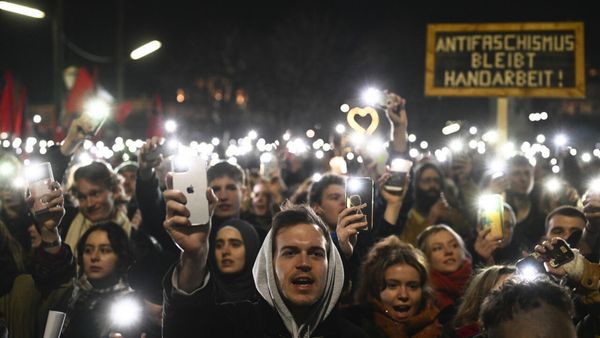
Many scholars of modern Chinese history tend to see the contemporary near-superpower status of the People’s Republic of China (PRC) as a decidedly recent phenomenon. Rapid economic growth after the formulation of “reform and opening up” policy and “socialism with Chinese characteristics” provided the country with the economic resources to influence global affairs through commercial, military, and technological means. These scholars contrast the post-1978 success of China with its pre-1978 poverty, suggesting that economic reforms have decidedly improved the livelihoods of the Chinese people while strengthening the Chinese state and the ruling Chinese Communist Party (CCP).
In Revolution and Counterrevolution in China, Lin Chun makes a powerful theoretical argument against the tendency to see 1978 as a concrete dividing line between two different Chinas. Instead, she places both the Communist Revolution and the economic reforms since 1978 in a lineage of continuous revolution in China back to the 1911 Xinhai Revolution, with a shared goal of ending China’s impoverished, semi-colonial status. In the process, she presents CCP rule since 1949 as a continuous social experiment to fulfill the ultimate goal of an independent, self-sufficient, egalitarian society.
Lin is particularly eloquent in postulating how the CCP was able to create an unprecedented sense of national unity in the decades before 1978, laying the groundwork that enabled economic reforms to be implemented at a nationwide scale. By focusing on the importance the CCP leadership placed on mass education and ideological propaganda, Lin demonstrates how the party created a “united front” of smallholder farmers and urban proletariat that institutionalized grassroots structure for supporting policy implementation. In Lin’s account, this united front provided necessary conditions for rural land reforms as well as large-scale industrialization after 1949, first solely as a state-led effort, and then one that involved an increasingly vibrant private sector after 1978.
Her argument that the CCP was able to create unprecedented national unity especially rings true considering the prevalence of warlords in pre-1949 China. While the Kuomintang (KMT) nominally controlled all of China by 1928 after defeating a succession of military cliques during the Northern Expedition, it relied on foreign-backed warlords in peripheral regions. The KMT itself was dependent on military and economic support from the Soviet Union, Nazi Germany, and finally the United States, during wars with warlords, Imperial Japan, and the CCP. Lin makes a compelling case that it was only through the CCP’s grassroots work that this militarized foreign-backed regime was isolated and neutralized.
Despite praising the CCP’s method for building a unified socialist Chinese identity through grassroots work, Lin remains clear-eyed about the challenges the CCP faced in fulfilling its ultimate goal of creating a classless society. In strong discussions of the reasons that the party failed to stamp out class cleavages in the PRC, Lin points to various new sources of social inequalities in an ever-expanding bureaucracy, urban-rural divide, and discrimination against children and grandchildren of the pre-1949 bourgeoise.

Lin’s passion for addressing the entrenched social inequality partly comes out of her personal experience. In a 1995 essay “Toward a Chinese Feminism: a Personal Story,” she recounts her life “reeducated” in the countryside during the Cultural Revolution as a teenager, coming after a relatively privileged upbringing in Beijing.
As Lin describes in her 1995 essay, in practice, the CCP leadership willingly sacrificed rural development for the sake of the country’s nascent industrialization. Sending young urbanites to the countryside during the Cultural Revolution exposed the existence of a persistent agricultural underclass bitterly struggling to survive. That persistent class divisions after 1949 logically justify a central thesis of Lin’s work that continued revolution in the PRC and its countervailing pushback were inevitable.
Yet, Lin also unwaveringly upholds the principle that the PRC state was created to ensure fairness and dignity for Chinese citizens, rejecting the often taken-for-granted popular assumption that the state sacrifices the short-term pursuit of equality in the name of encouraging disruptive innovation, which ultimately, in the long-term, improves the lot of all citizens despite enriching some first.
Noting that China continues to undergo sociopolitical revolution and counterrevolution, Lin marshals evidence that fulfilling the original goal of an egalitarian socialist state acts as the sustained driver of major events in modern Chinese history. While acknowledging the massive, unnecessary deaths and human rights violations, Lin casts the Great Leap Forward and the Cultural Revolution as a problem of egalitarian ideals and failed execution, a view that has been a subject of considerable debate.
Lin also claims that post-1978 China is no more successful in securing social and economic security for its citizens than its pre-1978 counterpart, Lin presents her case that the PRC state’s myriad technological innovations stemming from the economic reforms actually threatens to subjugate the country again to pre-1949 dependency on foreigners, rather than allowing the country to leapfrog foreign powers and become more self-sufficient. While her arguments are persuasive, the practical applicability of her case for a continued revolution in China toward a more egalitarian future remains highly questionable. There is simply no evidence to suggest that China’s leadership today aspires to the kind of revolution Lin suggests ought to take place to make the country more socially equitable.
Instead, as the ethos of modern China has become ever more defined by aspirations to lead better lives than in foreign countries, many more citizens are willing to sacrifice the well-being of their compatriots in the process of getting there. Lin worries, justifiably in my view, that this flow can no longer be held back by even the most thorough and faithfully implemented ideological education. But the inequality has served the current crop of political and business elites well. They have managed to enrich them through means both fair and foul, as detailed vividly in a recent memoir by former insider Desmond Shum. The CCP leadership no longer has – if we grant that it once did – the slightest interest in serving as a “revolutionary vanguard,” as Lin hopes that it will.
Indeed, the CCP, in reality, has gone in a completely different direction. Instead of reducing inequalities among different minorities, the state has institutionalized the suppression of Tibetan, Uyghur, and Mongol culture. Instead of countering materialism, officials have hounded expressions of spiritual alternatives, from religion to feminism to neo-Maoism. And instead of aspiring to socialist internationalism, or even just a standard liberal cosmopolitanism, the party has whipped up fervent nationalism that has boiled over into international diplomatic and commercial issues. Looking at contemporary Chinese society and politics, it is difficult to see Lin’s call to advance equality receiving much of an audience in China or elsewhere.
These questions aside, Lin brings to bear a truly impressive theoretical framework that goes well beyond China. In particular, Lin repeatedly refers to Leninist, Trotskyist, Marxian, and Weberian political principles in discussions of how the CCP leadership thought about the directions that the new PRC state ought to develop. By linking Maoist political principles and those of other political and philosophical thinkers, both historical and contemporary, Lin further buttresses her argument that the Communist Revolution in China was “world-historical” and has implications far beyond China’s political and cultural boundaries.
While packing in so many different theoretical perspectives, Lin keeps the discussion of CCP’s modus operandi concise, direct, and clear by cutting out any superfluous background information. For instance, she only refers to relevant historical events as needed in her theoretical descriptions.
For scholars of Chinese and world history, there is little doubt that the formulation and the continuing changes in the PRC impact political and economic developments around the world. But even in the increasingly crowded field of scholars analyzing how the CCP intends to govern China, Lin’s is a voice worth paying attention to, not just for her insight into many of the events that she describes, but also as a window into the thinking of a contemporary and critic of the generation currently in power in China. Unlike some of her those in power, though, Lin believes in the promise of a different future for her country.
READ NEXT: Do China and Africa Allow Us to Bring Back the Idea of Civilization?
TNL Editor: Nicholas Haggerty (@thenewslensintl)
If you enjoyed this article and want to receive more story updates in your news feed, please be sure to follow our Facebook.







